AC Joint Injuries and Pain
(Albert Lin, MD; Paul Yannopoulos, BA; Jon JP Warner MD)
The acromioclavicular joint, or the AC joint, is a joint on the top of your shoulder that connects the clavicle (collarbone) to the scapula (shoulder blade). The acromion is part of the scapula. It is the bony prominence that can be felt at the top of your shoulder.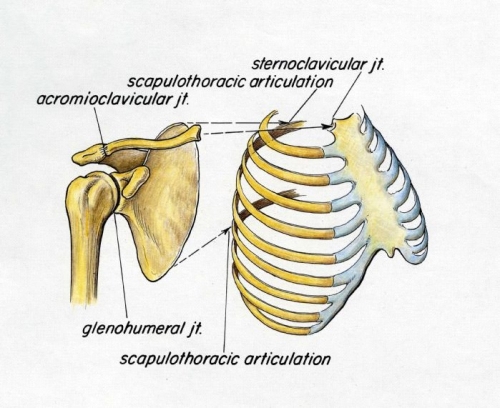 Strong ligaments connect the acromion to the clavicle at the AC joint, and a cartilage disk exists between the two, acting like a cushion. This joint is important in that it connects the shoulder girdle to the rest of your skeleton. It is one of the most common sites of shoulder pain and can be frequently injured.
Strong ligaments connect the acromion to the clavicle at the AC joint, and a cartilage disk exists between the two, acting like a cushion. This joint is important in that it connects the shoulder girdle to the rest of your skeleton. It is one of the most common sites of shoulder pain and can be frequently injured.
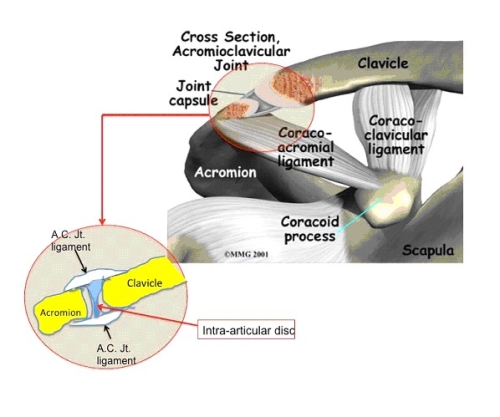
Normally a cartilage disk is present between the acromion and clavicle at the AC joint. This disk normally acts as a cushion that allows for the acromion and clavicle to rotate with respect to each other when the shoulder moves. However, sometimes this disk can degenerate leading to a loss of the cushion, or it can be damaged with a traumatic event such as a fall onto the shoulder or repetitive overhead motions or even weight lifting. This can result in pain and sometimes mechanical symptoms such as clicking or catching. Inflammation can progress to a condition called osteolysis which is a degeneration of the joint with resorption of the ends of the bones of the joint. This condition has typically been described in weightlifters.
Sometimes pain can also be due to to painful arthritis. While arthritis can be a normal aging process, it can also be the result of trauma or repetitive overload of the joint. In such cases it is called traumatic arthritis

The AC joint is a frequent site of injury. Often, the mechanism of injury is a fall directly onto the top of the shoulder or in sporting activities, such as football or hockey in which there is significant impact to the top from a tackle or being checked into the boards.
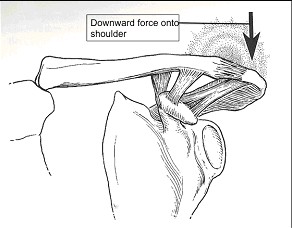
The AC joint is connected by strong ligaments. These ligaments run between the Clavicle and acromion and between the coracoid bone of the scapula and the clavicle (coracoclavicular ligaments). These ligaments can be stretched without tearing (grade I sprain) or they may be torn partially (Grade II sprain) or completely (Grade III, IV, or V sprain). After an injury, pain can develop either because the ligaments have been stressed (sprained) or torn, or the disk within the joint is injured (see above section on AC joint pain). If the ligaments are torn severely enough, this can lead to a deformity of the A.C. joint where the end of the clavicle appears to be prominent. This is due to loss of the normal suspensory support of the arm so the arm and shoulder appear to droop downward and the outer end of the clavicle appears to be prominent. In lay terms, this is often what is referred to as a “shoulder separation.” Some patients with a severe shoulder separation can develop acute or chronic pain and a feeling that the joint is moving around, or unstable.
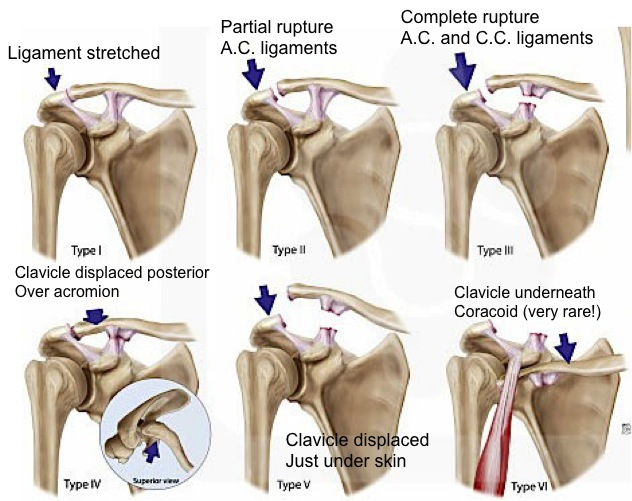
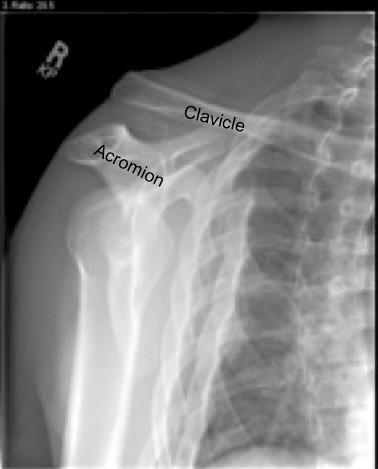
AC joint pain either from arthritis or osteolysis can be treated in many ways. Conservative treatment is the first approach and this usually consists of rest, modifying activities in order to avoid pain, taking anti-inflammatory medications, using a combination of heat and cold application, and formal physical therapy which may use modalities such as ultrasound. When the conservative approach is not successful in achieving pain relief, an injection of steroid and anesthetic (i.e. Marcaine) into the A.C. joint can be very helpful. The injection usually serves two purposes. First, it decreases inflammation and many patients feel dramatic relief from the injection. Second, if the pain goes away with an injection, it confirms that the AC joint is the source of the pain.
In cases where the pain continues to affect the patient’s quality of life despite conservative treatment, surgery becomes an option. This surgery involves removing a small portion of the end of the clavicle and acromion along with the torn intra-articular disc, in order to make room so that there is no irritation from compression of the joint surfaces. This surgery can be performed either using arthroscopy or as an open surgery with an incision as both have the same level of effectiveness.
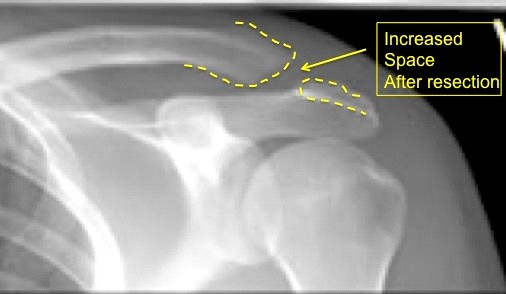
How Successful is A.C. joint resection?
92% of patients have pain relief after surgical A.C. joint resection.
Open versus arthroscopic acromioclavicular joint resection: a retrospective comparison study. Elhassan B, Ozbaydar M, Diller D, Massimini D, Higgins LD, Warner JJ. Arthroscopy. 2009 Nov;25(11):1224-32.
The treatment for an AC joint separation is controversial. For most A.C. joint separations conservative treatment is an accepted method of management. This is certainly appropriate for Grade I and II injuries. Grade III injuries may be treated conservatively with good pain relief and function if the patient is willing to accept the prominence of the clavicle. Some surgeons recommend immediate surgical stabilization using either a screw or sutures; however, there is little clinical experience reported in the literature to support this approach.
With more severe separations of the A.C. joint such as Type IV and V, there is a higher incidence of pain and limited function with conservative treatment so more immediate surgery is a reasonable approach.
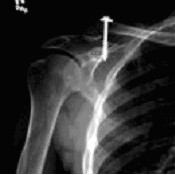
If the A.C. joint separation is chronic (more than a few months), the AC joint is usually reconstructed using ligaments local ligaments in the region of the shoulder , or a cadaver tendon (allograft) and a combination of,sutures. Most surgeons now prefer the latter approach due to the stronger construct than local ligament reconstruction. This is done either as a combined arthroscopic surgery or as an entirely open surgical procedure.
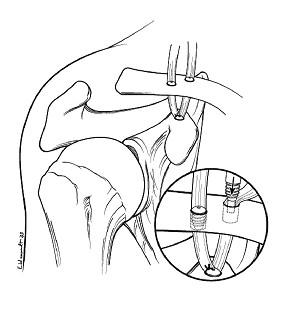
After Arthroscopic (or open) A.C. joint resection:
This procedure is usually performed as an outpatient surgery and you will be discharged home on the day of surgery. You will wear a sling and a cold compression device for a day or two for pain relief. Then the sling may be removed and you can start to use your arm for daily living activities such as washing, dressing and driving. Your surgeon will provide more specific recommendations regarding the role of therapy and return to sports participation.
After A.C. Joint Reconstruction:
Your surgery is usually an outpatient surgery and you will be discharged home on the day of surgery. You will wear a sling and periodically apply a cold compression device to reduce swelling over the first few days after surgery. The sling will be worn for six weeks in order to allow the ligament reconstruction to heal. You will be permitted to remove the sling to go in the shower after one week, but you should not remove the sling to use your arm freely during the day. You can use your hand for eating meals and for typing on a computer. More guidelines for recovery are available in our P.T. Protocols.
91% of patients had an excellent result after A.C. Joint Reconstruction (Ladermann A, et al: Acromioclavicular and coracoclavicular cerclage reconstruction for acute acromioclavicular joint dislocations. J Shoulder and Elbow Surg., 2011, April, (20)3: 401-8.
Most patients have excellent outcome after reconstruction (Salzmann GM et al: Arthroscopically assisted two-bundle anatomic reconstruction of acute acromioclavicular joint seprations. Am J Sports Med. 2010 June; 38(6): 1179-87.
Conservative treatment can result in excellent outcomes for A.C. Joint Separation (Cote MP et al: Rehabilitation of Acromioclavicular Joint Separations: Operative and Non-operative Considerations. Clin. Sports Med. 2010 April; 29(2): 213-28.
95% success with A.C. Joint Ligament reconstruction (Carofino BC and Mazzocca AD: The Anatomic Coracoclavicular ligament reconstruction: Surgical technique and indications. J Shoulder Elbow Surg. 2010 March; 19:37-46.
Treatment of A.C. Joint seprations must be individualized to the patient (Simovitch R et al: Acromioclavicular joint injuries: Diagnosis and Management. J Amer Acad Orthop. Surg. 2009 April; 17(4);207-19.
96% of patients with a good or excellent outcome after A.C. Joint Reconstruction (Tauber M et al: Semitendinosis tendon graft versus modified Weaver-Dunn procedure for acromioclavicular joint reconstruction in chronic cases: a prospective comparison study. Am J Sports Med. 2009 Jan; 37(1):181-90.
